The exporting to an XML file recipe has already explained the importance of XML in Dynamics AX, and how XML documents could be used for exporting data from the system.
In this recipe, we will continue about XML. We will create a piece of code that reads XML files. As a source file, we will use the previously created accounts.xml file.
Open AOT, and create a new class called ReadXmlFile with the following code. Replace
<documents>with your own path (use double backslashes for folder separation, i.e.\\):class ReadXmlFile { } public static void main(Args _args) { XmlDocument doc; XmlNodeList data; XmlElement nodeTable; XmlElement nodeAccount; XmlElement nodeName; #define.filename('<documents>\\accounts.xml') ; doc = XmlDocument::newFile(#filename); data = doc.selectNodes('//'+tablestr(LedgerTable)); nodeTable = data.nextNode(); while (nodeTable) { nodeAccount = nodeTable.selectSingleNode( fieldstr(LedgerTable, AccountNum)); nodeName = nodeTable.selectSingleNode( fieldstr(LedgerTable, AccountName)); info(strfmt( "%1 - %2", nodeAccount.text(), nodeName.text())); nodeTable = data.nextNode(); } }
Run the class. Infolog should display the contents of the
accounts.xmlfile on the screen:

In this recipe, we first create a new XmlDocument. We create it from the file and hence we have to use newFile(). Then we get all the document nodes of the table as XmlNodeList. We also get its first element by calling nextNode().
Next, we loop through all the list elements and do the following:
Get an account number node as an XmlElement.
Get an account name node as an XmlElement.
Display the text of both nodes in Infolog. Normally, this should be replaced with more sensible code to process the data.
Get the next list element.
In this way, we retrieve the data from the XML file. A similar approach could be used to read any other XML file.



